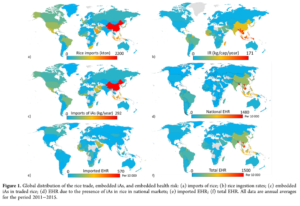Understanding global trade networks could help us spread the load of environmental contamination
Rice travels a long way to get to your dinner plate. It may have been harvested from a paddy field in Vietnam, processed and packaged in a factory in Bangladesh, and transported via freight ship to eventually land in your local supermarket.
But even before it was harvested, the water used to irrigate your rice has already undergone a spectacular journey – one that may have impacts on your health.
Below the earth’s surface, layers upon layers of gravel, sand, and fractured rock (aquifers) store 98% of the world’s liquid freshwater. More and more countries are relying on groundwater for drinking, cooking and irrigating their crops.
But troubles arise when this groundwater is contaminated with harmful substances. Many rice-growing regions have naturally high concentrations of arsenic in their soil and groundwater, which can be exacerbated by human activities, like coal mining. When we grow and irrigate crops in these susceptible locations, unhealthy levels of arsenic can accumulate in our food.
Inorganic arsenic is a carcinogen. Ingesting it over long periods can lead to skin and lung cancer, as well as pulmonary and cardiovascular diseases. Rice grown in regions like West Bengal and Vietnam contains high levels of inorganic arsenic. This poses a health risk for local communities that eat the rice, but also, for their global trade partners. India and Vietnam are two of the biggest exporters of rice on the global market.
Luckily, research-backed policy reform could offer a solution. By studying our global food networks, we can trace environmental contaminants as they move from farm to plate, and potentially, design policies that will “spread the load” of embedded health risks across the world.
“As consumers in a highly networked global trade system, we need to be aware that health and environmental risks start with the conditions under which our food is produced. The global trade system is important for the food security of the world and our oversight of that trade needs to take account of unequal distribution of environmental and health risks."
Associate Professor Patrick O’Connor, from the Centre for Global Food and Resources at the University of Adelaide.
O’Connor and a team of researchers associated with the Chinese Academy of Sciences, recently conducted a study that modelled how rice containing inorganic arsenic is traded and consumed across the world – and by extension, who is bearing the burden of embedded health risks.
For each country in their model, they considered data about concentrations of inorganic arsenic in rice, average daily rice consumption, how much rice is produced and exported, and how much is imported (and from where). Using this information, they modelled the health risk associated with arsenic consumption for each country.
What emerged was a picture of how inorganic arsenic (and its associated health risk) moves through our world. Countries like China and Indonesia, that rely heavily on rice imports from arsenic-rich Vietnam, had the highest imported health risk. Other countries, that distributed their rice imports across Thailand, India and Pakistan, had a lower calculated health risk.
“For the first time we are able to link embedded health risks in the food system across the global trading network,” says Patrick. “Our results give policy makers evidence for action on ensuring risks are mitigated by mixing imports”.
The researchers are now examining how global trade can more equitably distribute environmental and health risks for a connected world.
[caption id="attachment_16548" align="alignleft" width="300"]
 Image credit: Nunes et al 2022[/caption]
Image credit: Nunes et al 2022[/caption]
Newsletter & social media
Join us for a sensational mix of news, events and research at the Environment Institute. Find out about new initiatives and share with your friends what's happening.
